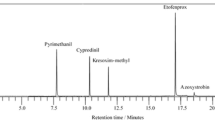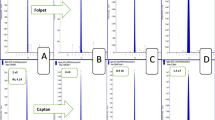Summary
The application of the combination open tubular column gas chromatography-mass spectrometry-computer for the detection and identification of organophosphorous pesticide residues in food was demonstrated. 23 of the most frequently used organophosphorous pesticides in Germany were separated on a 20 m SE-54 glas capillary column with the exception of the pair phosphamidone/fenchlorphos. Detection and identification of the individual pesticides were performed by chemical ionization mass spectrometry (CI) with isobutane and computerized background subtraction. In an example 10 of these substances were detected in cherries at a residue level of 0.45 ppm by comparison of CI mass spectra. — Mass fragmentography with single and multiple ion detection allowed the unequivocal identification of these 10 pesticides at the 40 ppb level in cherries. The detection limit of the pesticides examined in this study was found in the lower ppb region in food extracts using CI with isobutane. The application of an integrated computer system allowed the determination of all 10 pesticides in a single gc run. — Comparing electron impact and chemical ionization with isobutane in mass fragmentography of organophosphorous pesticide residues in food a considerable lower detection limit was observed using the chemical ionization procedure.
Zusammenfassung
Es wird die praktische Anwendbarkeit der Capillargaschromatographie-Massenspektrometrie-Kopplung für den Nachweis von Organophosphorpesticid-Rückständen in Lebensmitteln gezeigt. 23 der am häufigsten in Deutschland verwendeten Organophosphorpesticide werden an einer 20 m langen SE-54-Glascapillarsäule mit Ausnahme des Paares Phosphamidon/Fenchlorphos getrennt. Der Nachweis und die eindeutige Identifizierung der einzelnen Pesticide gelingt durch Chemische Ionisation (CI) mit Isobutan und untergrundkorrigierte Massenspektren. 10 dieser Pesticide werden beispielhaft in einem Kirschextrakt in einer Konzentration von 0,45 ppm Durch Vergleich der CI-Massenspektren identifiziert. — Massenfragmentographie mit Einzel- und Mehrfachmassenregistrierung gestattet den eindeutigen Nachweis von je 40 ppb der 10 ausgewählten Pesticide in Kirschextrakt bei Verwendung der Chemischen Ionisation mit Isobutan. Die Nachweisgrenze der meisten Pestizide liegt im unteren ppb-Bereich in Lebensmittelextrakten. — Durch Verwendung eines integrierten Computersystems mit emem geeigneten Zeitprogramm lassen sich alle 10 Pesticide in einer einzigen gaschromatographischen Analyse eindeutig bestimmen. — Verglichen mit der Elektronenstoßionisation liegt die Nachweisgrenze für Organophosphorpesticid-Rückstände in Lebensmitteln bei Anwendung der Chemischen Ionisation mit Isobutan in der Massenfragmentographie wesentlich niedriger.
Similar content being viewed by others
Literatur
Empfehlung der Arbeitsgruppe „Pestizide” Mitt. Bl. GdCh-Fachgr. Lebensm.-gerichtl. Chem.25, 129 (1971)
Stan,H.-J., Abraham,B., Behla,L., Kellert,M.: Mitt. Bl. GdCh-Fachgr. Lebensm.-gerichtl. Chem.30, 146 (1976)
Van der Velde,G., Ryan,J.F., J. Chromatog. Sci.13, 322 (1975)
Stan,H.-J.: Chromatographia10, 233 (1977)
Höchstmengenverordnung Pflanzenschutz, pflanzliche Lebensmittel vom 30.11. 1966, zuletzt geändert am 4.2. 1976
Stan, H.-J.: Fresenius Z. Anal. Chem. (im Druck)
Becker,G.: Dent. Lebensm.-Rundschau67, 125 (1971)
Grob,K., Grob,G.: Chromatographia5, 1 (1972)
Stan, H.-J., Abraham, B., Jung, J., Kellert, M., Steinland, K.: Fresenius Z. Anal. Chem. (im Druck)
Blum, W.: Application Tips (Hrsg. Fa. Finnigan, München), No. 7 (1972)
Author information
Authors and Affiliations
Additional information
Teil eines Vortrages bei der 12.Sitzung des Arbeitskreises NOW, Fachgruppe Lebensmittelchemie und gerichtliche Chemie, Ges. Deutscher Chemiker 10. März 1977
Rights and permissions
About this article
Cite this article
Stan, HJ. Nachweis von Organophosphorsäureester-Rückständen in Lebensmitteln im PPB-Bereich durch Capillargaschromatographie-Massenspektrometrie-Kopplung. Z Lebensm Unters Forch 164, 153–159 (1977). https://doi.org/10.1007/BF01263021
Received:
Issue Date:
DOI: https://doi.org/10.1007/BF01263021




